What’s the big deal with independence in Montessori preschool?
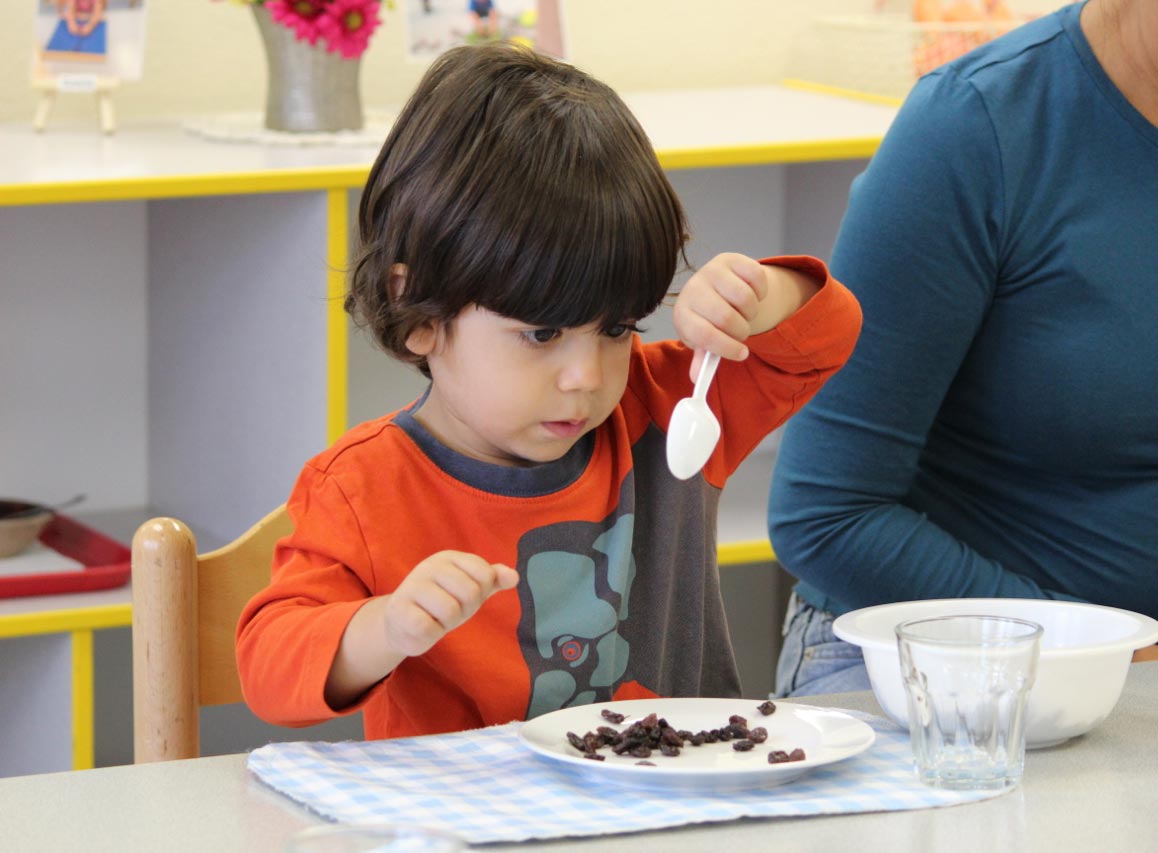
Montessori preschool and toddler programs place much more emphasis on helping children become independent than other programs do. Why is that? Does it really matter whether a 2-year-old can put on his own jacket, or whether a 5-year-old can peel a carrot or tie his shoelaces?
When parents first see the snack routine in one of our Montessori toddler environments—setting the table, serving themselves and each other, and cleaning up after themselves—they are stunned. Often, parents are concerned that their own 18-month-old won’t ever be able to fit into this group of toddlers who seem so mature and capable!
What is it about a Montessori preschool and toddler environment that enables young children to competently do for themselves things that much older children still can’t do in other settings?
According to Dr. Montessori, educating young children is educating them for independence:
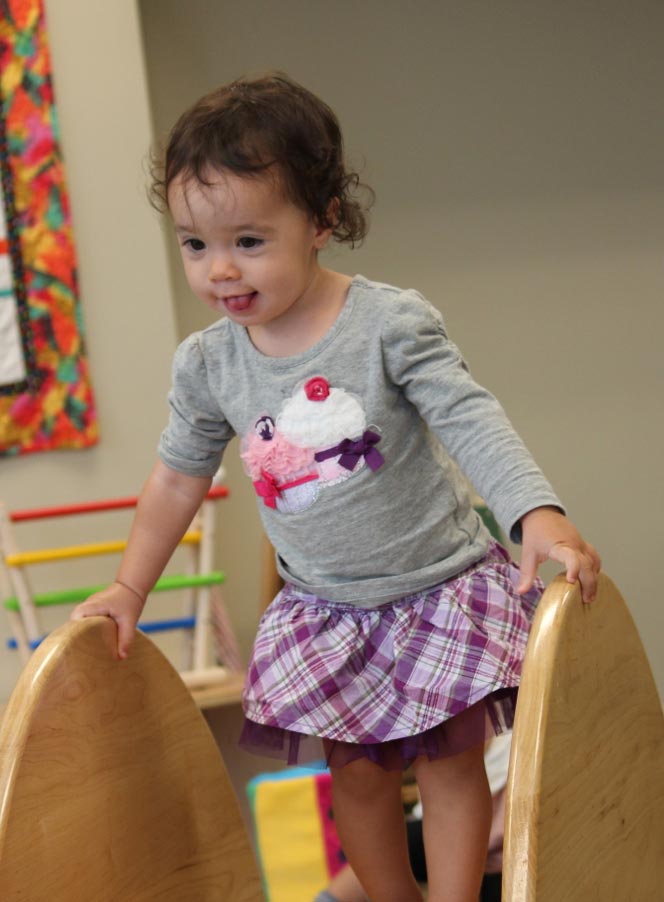
If teaching is to be effective with young children, it must assist them to advance on the way to independence. It must initiate them into those kinds of activities which they can perform themselves and which keep them from being a burden to others because of their inabilities. We must help them to learn how to walk without assistance, to run, to go up and down stairs, to pick up fallen objects, to dress and undress, to wash themselves, to express their needs in a way that is clearly understood, and to attempt to satisfy their desires through their own efforts. All this is part of an education for independence.Dr. Maria Montessori
Toddlers are naturally eager to learn these things. “Do it myself” might well be the refrain for the toddler years!
Unfortunately, our day-to-day lives often make for less than ideal circumstances to help our children achieve the independence they crave. Our homes are not optimized around a little person with his height of less than 3 feet: Objects are hard to reach, too heavy, or too big for little hands to use. Our days are not set up to move at his speed: We rarely just happen to have 10 spare minutes to wait while our 2-year-old puts on his jacket!
Yet enabling a toddler to become more independent has huge benefits, both near-term and longer-term.
Power struggles decrease when a child feels more in control. Temper tantrums are less frequent when a toddler is busy doing things for himself rather than resisting his parent’s efforts to do things for him!
A child who feels capable because he can act in the world, without needing to rely on Mom or Dad for every little thing, is a child who is developing self-confidence. Writes psychologist Madeline Levine: “Self-esteem doesn’t contribute much to success. But success contributes mightily to self-esteem. Kids have to “do” something, and do it well, to get a self-esteem boost.”
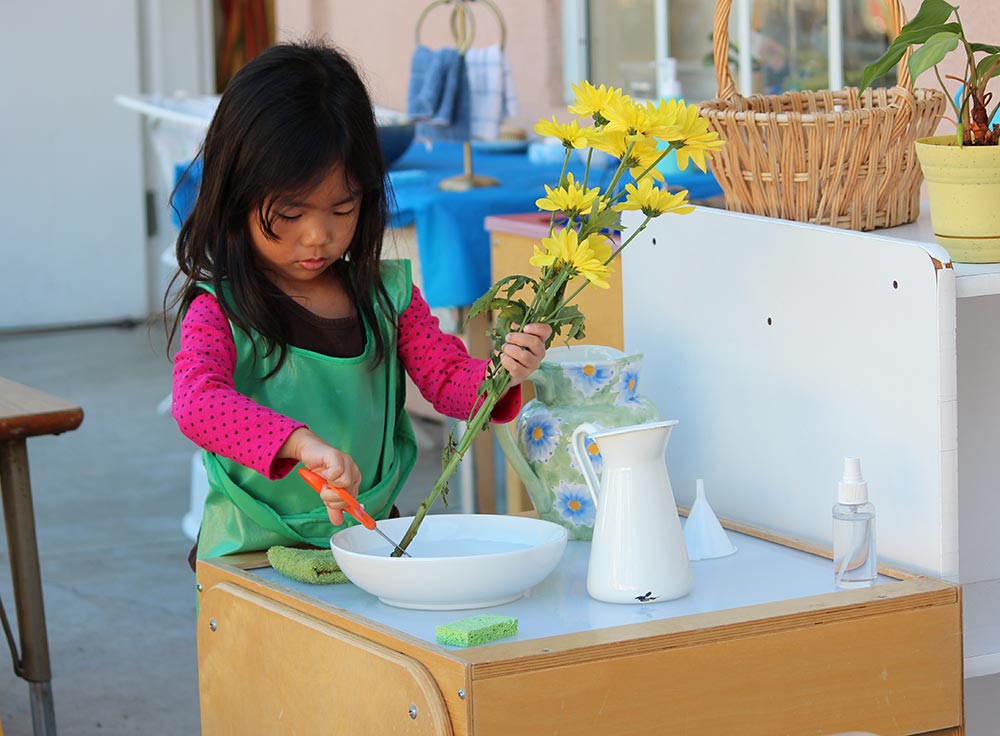
Children who start to contribute to the home’s smooth functioning in little ways reap many long-term benefits. A great recent article in Wired Magazine points out many of these benefits, and offers a great quote to the educational benefits of involving children in real daily tasks:
So many educational tasks put before our children serve no purpose other than to instruct. But when learning is connected to something truly purposeful, it can’t help but kindle motivation. Children feel honored to be included in real work that includes real challenges. If we pay attention, we see that’s just what they pretend to do when they play. Article in Wired Magazine
So if independence is vitally important, how do we go about fostering it?
Let’s start by quoting some hard-hitting words from Dr. Montessori:
We wait upon our children; and to serve them in this way is not less fatal than to do something that would tend to suffocate their own useful, spontaneous activities.We believe that children are like puppets. We wash them and feed them as if they were dolls. We never stop to think that a child who does not act does not know how to act, but he should act, and nature has given him all the means for learning how to act. Our primary duty toward him is to assist him to perform useful acts. A mother who feeds her child without taking the least effort to teach him how to hold a spoon or to find his mouth, or who, when she is herself eating, does not at least invite him to watch how it is done, is not a good mother. She offends her son’s human dignity by treating him as a puppet, whereas he is by nature a man that has been entrusted to her care. Everyone knows that it requires much more time and patience to teach a child how to eat, wash, and clothe himself than it does to feed, bathe and clothes him by oneself.The one who does the former is an educator; the latter performs the lower office of a servant. Dr. Maria Montessori
A goal in our classroom is to act as an educator, in the sense that Dr. Montessori describes above, as someone who guides your child toward independence. How do we approach this responsibility?
Here are four key principles that help us as we guide our students to independence. These principles hold true in the Montessori preschool and toddler environments, and you can apply them at home, too:
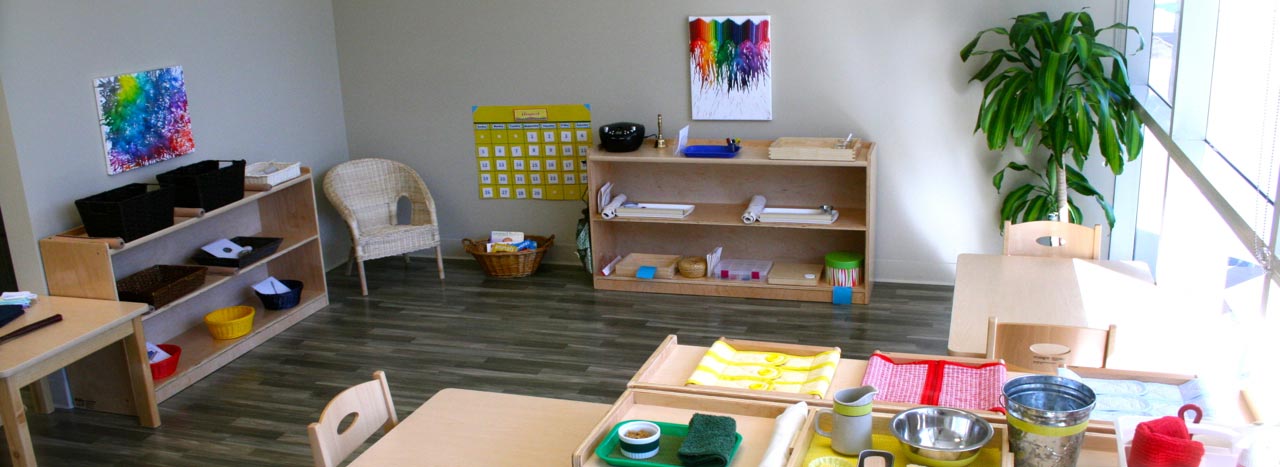
- Prepare the environment. The Montessori preschool and toddler classrooms are optimally prepared to support children’s independence. All furniture is child sized, as are tools, from small plates to low toilets, from miniature brooms to toddler-sized screwdrivers. The classroom is entirely organized around the child’s day: Shelves are filled with materials carefully selected for toddlers or preschoolers to handle successfully, on their own. We even have dedicated activities to teach specific skills: color-coded trays with pouring activities that start with beans and progress to rice and then water; dressing frames to teach buttoning, zipping and so on; a multi-step set of materials to teach the skills needed to wash a table (sponging, folding cloths, pouring water…).Obviously, this is not an environment you can easily replicate at home! But there are steps you can take to make your home more supportive of your toddler’s independence. Here are some starter ideas:
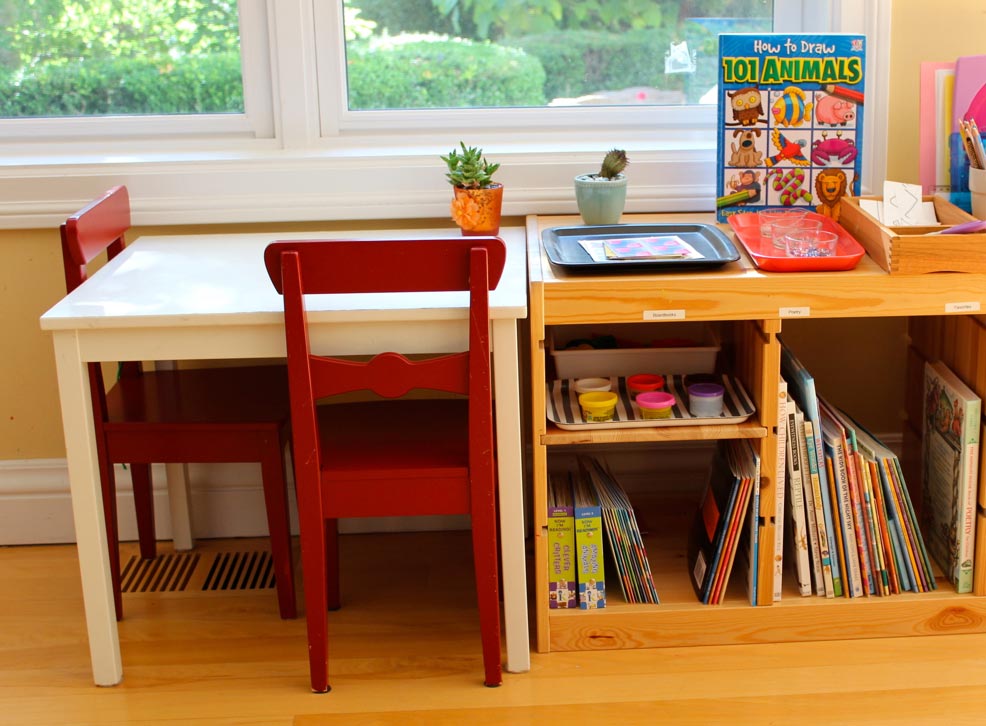
- Give your child access in the kitchen. Arrange plates and silverware for him on a low open shelf, or in a drawer. Provide a step stool so he can reach the counter to work with you, or place a small table and chair in the kitchen for him to work at.
- Organize the family room so he can participate. Toddlers don’t deal well with clutter. It’s best to offer low shelves with only a few toys out at a time and a place for each item. That way, he can put his things away, and find them, when he needs them.
- Set up his room and bathroom to support his growing independence in dressing and washing up. Look for a high step stool that will enable our child to access the sink. In his room, display a few (3-4 at most) sets of clothing on a low shelf or in shallow baskets. Make there’s a clothes hamper for him to place dirty clothes in at the end of the day.
- Teach individual skills, step-by-step. Remember those toddlers conducting their own snack routine? They didn’t learn all that in a day! In a Montessori classroom, we build skills slowly, one simple step at a time. This ensures children can succeed, which not only makes them happy, but also keeps them motivated to learn more. So for the snack routine, we break it down into very small steps (e.g. placing the plates on the table, setting a napkin at each place, scooping one spoonful of raisins, etc.), each to be mastered one at a time, and teach each step separately.A similar, slow approach can help your child gain independent at home and feel like he’s contributing.
Pick easy things first, and pick things your child wants to do. They don’t need to be the most obvious things, either: In our family, one of the first contributions my son made was to help make coffee; he loved scooping the beans into the grinder! Over time, we added other steps: opening the difficult closure of the coffee bean container, then closing it. Placing the cover on the grinder (tricky – it only goes on one way, and has to be totally vertical!) Getting the filter paper out of the cupboard, and carefully folding it so it fits in the filter cone. He can’t quite make the coffee by himself yet (the full can of water is still too heavy for him to pour), but he sure feels like he’s making me coffee, and it’s become a treasured part of our morning routine!

Here are some skills your toddler might well be ready for:
- Setting his place at the table. You can make him a placemat with outlines of plate, spoon, fork and cup. Or you can show him one thing at a time.
- Feeding himself. Start with finger foods, then introduce spoon and fork. Allow ample time for your 2-year-old to feed himself—and resist the urge to take over!
- Drinking out of a small glass or cup, not a sippy cup or other closed cup.
- Carrying dirty dishes into the kitchen. An older toddler can scrape his plate into the trash can, and perhaps even place it in the dishwasher with some coaching.
- Putting on his clothes, especially underwear, pants and skirts. Even jackets are a possibility, with the Montessori flip (see a video here!)
- Taking off his clothes (with the exception of tight-fitting t-shirts, which can be a struggle for a while.)
- Putting dirty laundry in a hamper after undressing.
- Hanging up a jacket on a peg or even a small hanger.
- Taking off his shoes and placing them in a designated spot (a basket or low shelf)
- Washing hands with soap and water and drying them independently.
- Slow down. One of the benefits of the Montessori preschool and toddler environment is the abundance of time. We are careful to preserve an unhurried day for our students, so that we can go at a toddler’s pace. Teachers plan for snack time to take up to 45 minutes. It’s perfectly all right if it takes 10 minutes to get everything ready, and 15 minutes to clean everything up: that slowness is when learning happens!At home, you won’t always have the time to slow down for your child. But it helps to think through your day to see if you can make time with those tasks where you’ll encourage your child’s independence. If weekdays are just too crazy (we understand!), then set aside an hour or two on the weekend. Spend time together in the kitchen, for example, to jointly prepare a meal.
- Embrace error. When toddlers and preschoolers learn, it can get messy. Things can and will get broken; liquids will spill; food will land on the floor. In Montessori preschool, we view all of this as a natural part of learning, not as mistakes. Cleanup is therefore a part of every activity, not something separate from it. For example, when we work with water, there’s always a sponge or cloth handy to wipe up spills.Dr. Montessori called this being friendly with error, and it’s a valuable idea to keep in mind as you help your child become more independent at home. Buy cheap plates that you won’t be mind seeing broken, for example. I’ll never forget how I had repeatedly asked my daughter to open our trashcan slowly, as it would fall down hard if opened too energetically. It didn’t sink in, until the cover one day fell down right onto one of her ceramic plates and broke it. Sure, there were tears and a mess to clean up. But after that experience, my daughter rarely forgot to handle our temperamental trashcan with care!
Independence is a big deal in Montessori preschool for many reasons, a number of which we haven’t even mentioned in this post (indirect preparation for other tasks, motor skill development, problem solving capabilities: the list is long. Feel free to ask us for more details any time!).
At a very fundamental level, though, the motivation for independence is clear. As Dr. Montessori says, “These words reveal the child’s inner needs: ‘Help me to do it alone.’”












